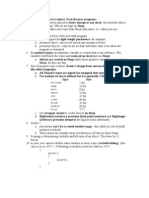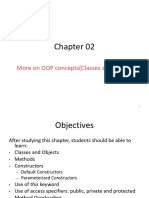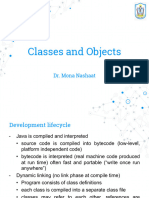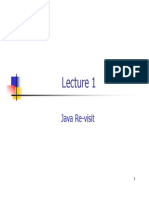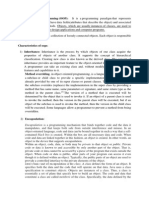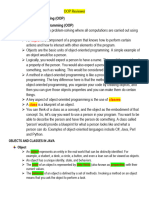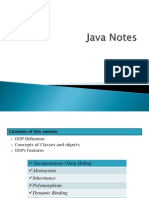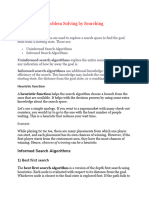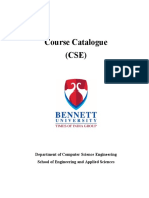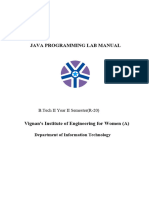0 ratings0% found this document useful (0 votes)
5 viewsJava Notes
The document discusses object-oriented programming concepts like classes, objects, attributes, methods, constructors, inheritance, polymorphism, encapsulation, and abstraction. It provides examples and explanations of key concepts.
Uploaded by
amrt6958Copyright
© © All Rights Reserved
Available Formats
Download as PDF, TXT or read online on Scribd
0 ratings0% found this document useful (0 votes)
5 viewsJava Notes
The document discusses object-oriented programming concepts like classes, objects, attributes, methods, constructors, inheritance, polymorphism, encapsulation, and abstraction. It provides examples and explanations of key concepts.
Uploaded by
amrt6958Copyright
© © All Rights Reserved
Available Formats
Download as PDF, TXT or read online on Scribd
You are on page 1/ 6
Notes:
1- Scanner method nextLine
Reads characters typed by the user until the newline
character is encountered.
Scanner method next
Reads individual words
2-Classes System and String are in package
java.lang.
Classes that are compiled in the same directory on disk
are in the same package—known
as the default package.
3-Attributes are represented as variables in a
class declaration.
Called fields.
Instance variable
When each object of a class maintains its own
copy of an attribute, the field is
an instance variable
4-Declaring instance private
is known as data hiding or information hiding.
5-it is elements are assigned the default value
for the numeric primitive data types 0,
'\u0000' for char types, and
false for boolean types.
0 int
0.0 double
null string, array, object class
6-Classes often provide public methods to
allow clients to set (i.e., assign
values to) or get (i.e., obtain the values of)
private instance variables
7-The primitive types are boolean , byte
, char , short , int , long ,
float and double .
•All nonprimitive types are reference types.
8 A constructor must have the same
-
name as the class.
9-By default, the compiler provides a default
constructor with no parameters in
any class that does not explicitly include a
constructor.
10-Sometimes there may be two or more possible matches for an invocation of a
method, but the compiler cannot determine the most specific match. This is
referred to as ambiguous invocation. Ambiguous invocation is a compilation
error.
11-A constant is declared with the keyword const—its value cannot be
changed after the constant is declared.
12-The Math class contains the following trigonometric methods and each
method has a single double parameter, and its return type is double.
13- The output from invoking Math.random() is random double value in
the range [0.0, 1.0).
14-a + Math.random() * b :
Returns a random number between
a and a + b, excluding a + b.
15-Array is a data structure that represents a collection of the same types of data
and the value of the variable is null, size is fixed.
16-The state of an object (also known as its properties or attributes) is
represented by data fields.
17-Constructors are a special kind of method
18-multiple constructors can have the
same name but different signatures.
19-A static variable is shared by all objects of the class.
20-Constants in a class are shared by all objects of the class. Thus, constants
should
be declared as final static. For example, the constant PIin the Mathclass .
21-Object-oriented programming allows you to define new classes from existing
classes. This is called inheritance.
22-The keyword super refers to the superclass of the class in which
super appears. It can be used in two ways:
■ To call a superclass constructor.
■ To call a superclass method.
23-A hidden instance variable can
be accessed by using the keyword this.
Use this to refer to the object that invokes the instance method.
Use this to refer to an instance data field.
Use this to invoke an overloaded constructor of the same class.
24-compiler automatically puts super() as the first
statement in the constructor.
25-To override a method, the method must be defined in the subclass using the
same signature and the same return type as in its superclass.
26-Overloading means to define multiple methods with the same name but
different signatures. Overriding means to provide a new implementation for a
method in the subclass
27-Private members can be accessed only from inside of the class, and public
members can be accessed from any other classes.
28-A final data field is a constant.
You might also like
- Unit 1 Partb: 1.explain OOP Principles. ClassNo ratings yetUnit 1 Partb: 1.explain OOP Principles. Class22 pages
- IX - Computer Applications - Promotional Exam NotesNo ratings yetIX - Computer Applications - Promotional Exam Notes14 pages
- OOP (O - O P S) : S Bject Riented Rogramming YstemNo ratings yetOOP (O - O P S) : S Bject Riented Rogramming Ystem50 pages
- Object-Oriented Programming (OOP) : It Is A Programming Paradigm That RepresentsNo ratings yetObject-Oriented Programming (OOP) : It Is A Programming Paradigm That Represents10 pages
- Chapter Three-I: Classes and Objects in JavaNo ratings yetChapter Three-I: Classes and Objects in Java32 pages
- CLASS AS USER DEFINED DATA TYPE AND CONSTRUCTORNo ratings yetCLASS AS USER DEFINED DATA TYPE AND CONSTRUCTOR4 pages
- ICSE Class 10 Computer Application NotesNo ratings yetICSE Class 10 Computer Application Notes29 pages
- More On Methods and Classes: CS F213: Object Oriented ProgrammingNo ratings yetMore On Methods and Classes: CS F213: Object Oriented Programming25 pages
- Master List of Java Interview Questions 115 QuestionsNo ratings yetMaster List of Java Interview Questions 115 Questions22 pages
- 22CS202 JAVA PROGG ANSKEY FIAT SIAT ME ESE 2022-2023No ratings yet22CS202 JAVA PROGG ANSKEY FIAT SIAT ME ESE 2022-202333 pages
- imp terms & definitions 10th to email. (1)No ratings yetimp terms & definitions 10th to email. (1)13 pages
- Java Programming Tutorial With Screen Shots & Many Code ExampleFrom EverandJava Programming Tutorial With Screen Shots & Many Code ExampleNo ratings yet
- Sec 4_Audio Signal Acquisition_ Read&Write Wave_ PlotNo ratings yetSec 4_Audio Signal Acquisition_ Read&Write Wave_ Plot12 pages
- LabExercise All DesignPrinciples Part1 StudentNo ratings yetLabExercise All DesignPrinciples Part1 Student4 pages
- Basic Concepts Of: Object Oriented ProgrammingNo ratings yetBasic Concepts Of: Object Oriented Programming73 pages
- Instant Download Exercises in Programming Style 2nd Edition Cristina Videira Lopes PDF All Chapters100% (2)Instant Download Exercises in Programming Style 2nd Edition Cristina Videira Lopes PDF All Chapters55 pages
- Option D: Object-Oriented Programming Revision GuideNo ratings yetOption D: Object-Oriented Programming Revision Guide43 pages
- Kotlin Tutorial For Beginners: Learn Kotlin Programming in 2 HoursNo ratings yetKotlin Tutorial For Beginners: Learn Kotlin Programming in 2 Hours27 pages
- Firstsource Sample Technical Placement Paper Level1No ratings yetFirstsource Sample Technical Placement Paper Level18 pages
- (Ebook) Beginning C++23 by Ivor Horton, Peter Van Weert ISBN 9781484293430, 1484293436 - Own the complete ebook set now in PDF and DOCX formats100% (1)(Ebook) Beginning C++23 by Ivor Horton, Peter Van Weert ISBN 9781484293430, 1484293436 - Own the complete ebook set now in PDF and DOCX formats80 pages
- Home Assignment - 3: Topic: Constructor & DestructorNo ratings yetHome Assignment - 3: Topic: Constructor & Destructor2 pages
- Mortennobel - Cpp-Cheatsheet - Modern C++ CheatsheetNo ratings yetMortennobel - Cpp-Cheatsheet - Modern C++ Cheatsheet13 pages
- 10 Most Useful Java Best Practice Quotes For Java DevelopersNo ratings yet10 Most Useful Java Best Practice Quotes For Java Developers5 pages
- CSC2071 - Lecture 26 (Mid Exam Solution)No ratings yetCSC2071 - Lecture 26 (Mid Exam Solution)5 pages
- C# Interview Questions You'll Most Likely Be AskedFrom EverandC# Interview Questions You'll Most Likely Be Asked
- IX - Computer Applications - Promotional Exam NotesIX - Computer Applications - Promotional Exam Notes
- OOP (O - O P S) : S Bject Riented Rogramming YstemOOP (O - O P S) : S Bject Riented Rogramming Ystem
- Object-Oriented Programming (OOP) : It Is A Programming Paradigm That RepresentsObject-Oriented Programming (OOP) : It Is A Programming Paradigm That Represents
- More On Methods and Classes: CS F213: Object Oriented ProgrammingMore On Methods and Classes: CS F213: Object Oriented Programming
- Master List of Java Interview Questions 115 QuestionsMaster List of Java Interview Questions 115 Questions
- 22CS202 JAVA PROGG ANSKEY FIAT SIAT ME ESE 2022-202322CS202 JAVA PROGG ANSKEY FIAT SIAT ME ESE 2022-2023
- Java Programming Tutorial With Screen Shots & Many Code ExampleFrom EverandJava Programming Tutorial With Screen Shots & Many Code Example
- Sec 4_Audio Signal Acquisition_ Read&Write Wave_ PlotSec 4_Audio Signal Acquisition_ Read&Write Wave_ Plot
- Instant Download Exercises in Programming Style 2nd Edition Cristina Videira Lopes PDF All ChaptersInstant Download Exercises in Programming Style 2nd Edition Cristina Videira Lopes PDF All Chapters
- Option D: Object-Oriented Programming Revision GuideOption D: Object-Oriented Programming Revision Guide
- Kotlin Tutorial For Beginners: Learn Kotlin Programming in 2 HoursKotlin Tutorial For Beginners: Learn Kotlin Programming in 2 Hours
- Firstsource Sample Technical Placement Paper Level1Firstsource Sample Technical Placement Paper Level1
- (Ebook) Beginning C++23 by Ivor Horton, Peter Van Weert ISBN 9781484293430, 1484293436 - Own the complete ebook set now in PDF and DOCX formats(Ebook) Beginning C++23 by Ivor Horton, Peter Van Weert ISBN 9781484293430, 1484293436 - Own the complete ebook set now in PDF and DOCX formats
- Home Assignment - 3: Topic: Constructor & DestructorHome Assignment - 3: Topic: Constructor & Destructor
- Mortennobel - Cpp-Cheatsheet - Modern C++ CheatsheetMortennobel - Cpp-Cheatsheet - Modern C++ Cheatsheet
- 10 Most Useful Java Best Practice Quotes For Java Developers10 Most Useful Java Best Practice Quotes For Java Developers


